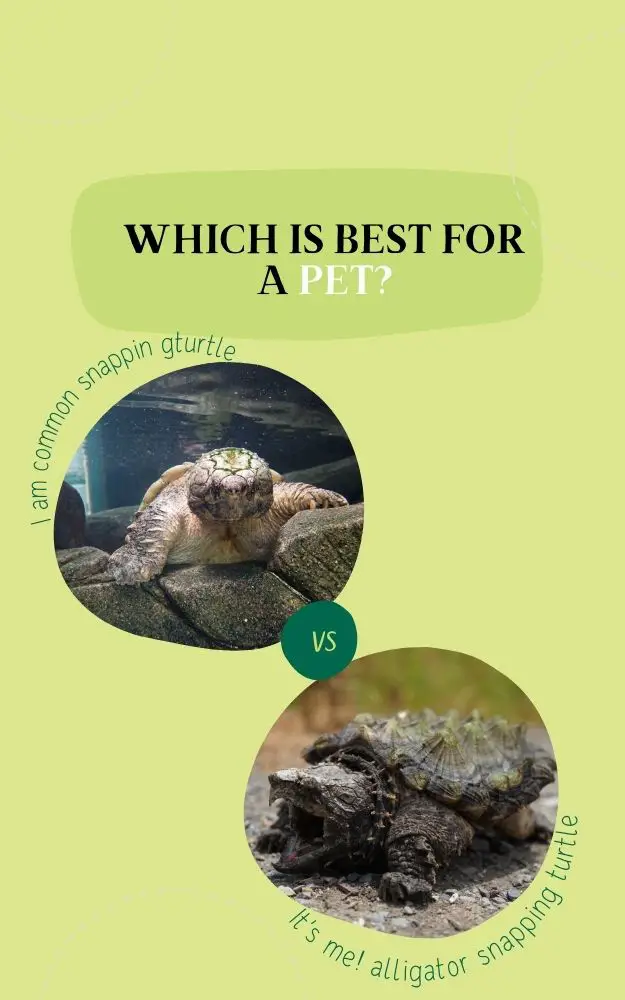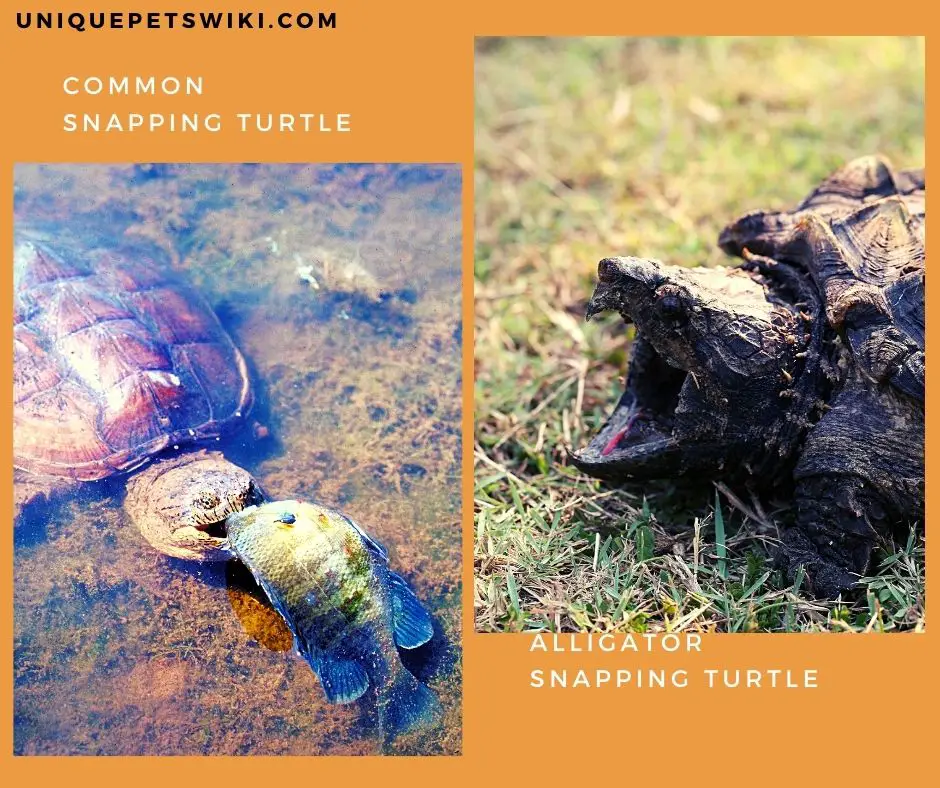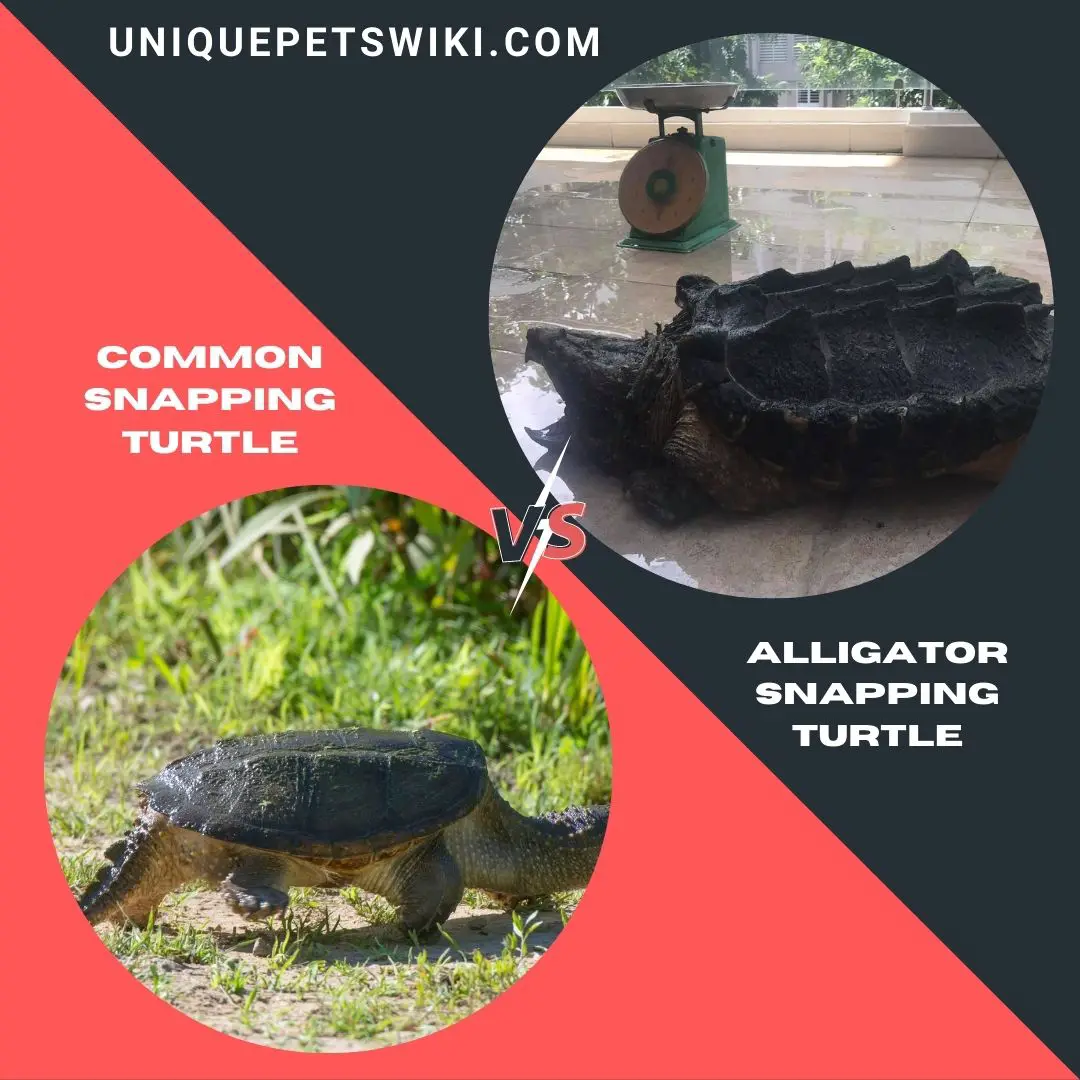Snapping turtles are often called the dinosaur of the turtle world due to their unique and primitive looks. Common snapping turtles and alligator snapping turtles are the only species of snapping turtles in the world.
Common snapping turtles and alligator snapping turtles have many similar features, and many people mistake them for each other. They are popularly known for their ability to inflict damage with their snapping jaws. However, there are some features that you can use to differentiate them from each other.
In this article, we will compare the common snapping turtle and alligator snapping turtle to show the differences and similarities between these species.
Contents
Snapping Turtle Vs Alligator Snapping Turtle
Common snapping turtles and alligator snapping turtles belong to the family Chelydridae. Both common snapping turtles and alligator snapping turtles have similar characteristics such as huge size, strong jawbones, diet, and so on.
Some of the similarities and differences between the common snapping turtle and alligator snapping turtle are stated below.
Appearance
The common snapping turtle looks like a regular turtle but is huge. Adult common snappers have rounded and smooth shells with long and spiky tails. They also have a round head with their eyes facing forward.
On the other hand, the alligator snapping turtle looks more like a prehistoric animal. They have three raised spiky ridges that run from their head to their tail which looks like an alligator, hence their name. They also have tougher skin with more wrinkles and bumps.
Unlike common snapping turtles, alligator snappers have an angular head, and their eyes are positioned on the sides of their head. Another great feature of alligator snapping turtles is that they have distinctive scales that look like small spikes, which helps to protect their eyes.
They also have a bright red, fleshy tongue lure which they use for attracting their prey.

Shape, Size, Weight
When it comes to size, snapper turtles are giants. However, alligator snapping turtles are bigger than common snapping turtles and are even the largest freshwater turtles in the world.
The shell length of an adult common snapping turtle is usually around 8-18 inches long. The males are usually larger than the female and can weigh around 10-35 pounds. On the other hand, the shell length of an adult male alligator snapping turtle is 29 inches, while the female can grow to about 22 inches.
The male alligator snapper can weigh up to 220 pounds, while the female weighs around 62 pounds on average.
Native Range And Habitat
Both common snapping turtles and alligator snapping turtles live in the same habitat.
Common snapping turtles originate from North America, and you can find them in places like Canada, New Mexico, and Florida. Common snapping turtles are freshwater species, and you can find them in brackish waters occasionally.
They are commonly found in habitats with slow-moving water, dense aquatic vegetation, and muddy bottoms.
Alligator snapping turtles originate from the Southeastern United States, and you will find them in places like central Illinois, eastern Texas, northern Florida, and Georgia. They are freshwater species and are usually found in the deepest water in their habitat.
They also prefer a habitat with muddy bottoms where they can hide.
Growth Rate And Lifespan
Common snapping turtles have a fast growth rate. At around two years of age, an average snapper usually has a shell length of around 5-6inches. The growth then slows down, and your snapper will grow to around 12-14 inches in 15-20 years.
On the other hand, alligator snapping turtles have a slow growth rate compared to common snapping turtles. However, they usually grow much bigger than common snapping turtles.
Both common snappers and alligator snappers have a long lifespan. In the wild, common snapping turtles can live for about 30 years, while alligator snapping turtles can live for 10-45 years. Furthermore, both can live for longer when kept in captivity.
Predators
Both common snapping turtles and alligator snapping turtles are usually vulnerable to predators as a hatchling. This is because they are tiny in size, and large animals can prey on them.
Some animals prey on snapping turtle hatchlings: mink, raccoons, crows, hawks, skunks, dogs, foxes, alligators, bears, and dogs. All of these animals can also prey on juvenile snapping turtles when they are hungry. Furthermore, adult snapping turtles can also eat baby turtles if they have the chance.
Humans can also hunt snapping turtles and alligator snapping turtles for their meat or for fun. Some fishermen kill them on sight because they believe snappers feed on the fish in the water, which can affect the number of fish stocks in the water.
Some turtles can also be hurt or killed accidentally, such as if a turtle gets injured by a boat propeller or a female turtle gets hit by a car when looking for a place to build the nest.
Video of river otter attacking an adult common snapping turtle in the wild.
Active Level
Both common snapping turtles and alligator snapping turtles spend most of their life in the water and only come out to bask. However, female turtles usually go to the land to dig their nest and lay eggs close to small streams.
Snapping turtles can stay underwater for about an hour and will only resurface for air. During the day, they usually hunt for food by lying motionless on the swamp floor or in muddy water. They will then open their mouths and wait for fish, frogs, or other small animals to ambush them.
However, they are more active at night and will forage for prey, carcasses, or anything they can eat.
Personality And Defense Mechanisms
Both common snapping turtles and alligator snapping turtles have a docile temperament, and it is quite easy to manage them as pets. They are usually calm but can be aggressive if triggered. Snapping turtles can be triggered if they are stressed or threatened.
Generally, snapping turtles are calm in the water but can be aggressive when on land. They are aggressive on land because they are usually insecure and feel predators can approach them.
However, both common snappers and alligator snappers have several defense mechanisms against prey. They have a hard shell and have ferocious bites to help protect them from attack by prey. They also produce a foul-smelling chemical under their shell when they want to be left alone.
Swimming/Run Ability And Speed
Although turtles may not be as fast as other animals, it is believed that they can run. This shows that both snapping turtles and alligator snapping turtles can run.
On land, the running speed of snapping turtles is about 2.4 mph. They usually move at a lesser speed on land due to their huge size. However, snapping turtles can swim faster in water than when running or walking on land.
The average swimming rate for snapping turtles is usually between 10-12 mph. They can swim fast because they have webbed shaped feet. They use their front legs for thrusting and moving forward while their rear leg is used as the steering.
Diet
Snapping turtles have a healthy appetite and are not picky eaters. They feed on aquatic plants, fish, aquatic insects, snakes, amphibians, small fish, small mammals, and even other turtles in the wild. They are both ambush predators as they blend in with the muds and plants while waiting for their potential prey.
Common snapping turtles, especially young turtles, usually display active hunting behavior. Furthermore, common snappers can be regarded as opportunistic omnivorous animals. This is because they can also feed on aquatic vegetation and roots.
On the other hand, alligator snapping turtles are more of a sit-and-wait predator. They can easily catch fish due to their unique adaptation and are entirely carnivorous. It is rare to find alligators snapping turtles feeding on plants.

Brumation
In the wild, common snapping turtles can hibernate in the northern part of their range during the harsh winters. When hibernating, they bury themselves in the muddy bottom of a lake and stay buried for six months. During this period, they usually breathe only through membranous gas exchanges.
However, not all common snapping turtles hibernate as they can tolerate high cold weather and stay active under ice sheets.
On the other hand, alligator snapping turtles originate from the warmer southern parts and don’t need to hibernate for long. They are usually active all year round in the wild and will even try to escape from colder parts during winter.
Some breeders recommend that you should not try to hibernate pet snappers during the first few years of their life. Furthermore, you should only try to hibernate if the climate in your area is comparable to their native habitat.
Mating
Generally, it usually takes longer for common snappers found in colder northern regions (15-20 years) to reach sexual maturity than those found in southern regions (12 years). Common snapping turtles start breeding for almost the entire year, from April to September.
On the other hand, alligator snapping turtles will reach sexual maturity at about 12 years of age. They usually mate every year during the spring period.
In the wild, mating is usually initiated with visual cues as the turtle will face each other and show different leg movements to show their intent. However, this is not common in turtles kept as a pet. During mating, the male will mount the female while holding her shell with its four feet.

Reproduction
After mating, female snapping turtles will leave the water to find a place to nest. They usually dig their nest far from the water to help protect the eggs from flooding. After making the nest, she will then lay her eggs which can contain more than 80 eggs.
The female turtle will then cover the nest and return to the water. The eggs will start to hatch after 80-90 days. After hatching, the tiny turtles will then head towards the nearest water and are quite vulnerable to many predators during this period.
Female turtles do not take care of their young ones, and they only eat whatever they can catch to help them survive.
Like common snapping turtles, alligators snapping turtle nests on dry land. After making the nest, the female will lay 9-50 eggs in a single clutch. The incubation period for alligator snapping turtles is between 100-140 days which is quite longer than the common snapping turtle.
After hatching, the turtles will also head towards the nearest water.
Required Take Care
Both snapping turtles spend most of their lifetime in the water, and they only come on land to lay eggs during the breeding season. Everything you will need to take care of your snapping turtles is stated below.
Enclosure Size
Both species usually grow large, and you will need to provide a large pool to help keep them happy and healthy.
You will need at least a 10-gallon aquarium for hatchling snapping turtles. However, adult snapping turtles will need a 120-gallon tank. On the other hand, you will need a 700-gallon tank for housing adult alligator snapper.
The water level should be semi-shallow and be as deep as the turtle’s shell. This means the water can be deep enough for your turtle to swim in but also shallow enough for your turtle to stick up its neck to the surface and breath.
You can use a glass terrarium, plastic fish ponds, large plastic tubs, and small children’s pools to house your snapping turtle. You also need to ensure that their enclosure should be secured with a sturdy wire to help prevent their escape.
It is also important that the water is treated and chlorine-free for the optimum health of your turtle.
Lighting, Heating, Humidity Requirements
Although both species prefer to be in the water, they can come out to bask occasionally.
You will need to provide a basking spot that is about 90F for common snapping turtles. You will need a UVB light if you are keeping your snapping turtles indoors. A UVB lighting will help your turtle to produce vitamin D and should be kept on during the day and off at night.
In captivity, they need a specific temperature range to stay healthy. The temperature in their enclosure should be between 78-80F for hatchlings and 75-78F for adults. You can use an underwater heater to achieve this temperature and add PVC tubes around the heater to help prevent burns.
On the other hand, alligator snapper turtles can be kept at an enclosure with a water temperature between 70-74F. The air temperature in their enclosure should also be over 65F, as anything below your snappers may not eat.
Last update on 2022-12-30 / Affiliate links / Images from Amazon Product Advertising API
It is recommended that you keep their temperature constant all year round to help prevent hibernation. If you keep your alligator snappers indoors, you will need to provide UVB light to synthesize vitamin D3.
Suitability: Best For Whom?
Both common snapping turtles and alligator snapping turtles are not suitable for beginner hobbyists. This is because they require huge enclosures and special care to keep them healthy and happy. However, both turtle species are more suitable for experienced hobbyists.
Costs
It is quite cheaper to buy a common snapping turtle than an alligator snapping turtle.
A baby snapping turtle can cost around $25 – $45, while an adult turtle can cost $150. On the other hand, baby alligator snapping turtles are usually between $40-$75 but can get a discount if you buy more than one. Adult alligator snapping turtles can cost more than $150.
Ability To Keep In Groups
Both turtle species are solitary, and they prefer to live alone. In the wild, you can find many snappers in the same area, but they do not interact with each other. The males are usually aggressive towards other males.
The number of species you can find in an area depends on the food available. However, you can find male and female snappers together during the breeding season.
Can You Keep Snapping Turtle Vs. Alligator Snapping Turtles Together?
No, snapping turtles are usually territorial, and it is best to house them alone. They prefer to have as few competitors for food and resources as possible. Furthermore, they are large-sized reptiles, and you will need to have a big space available before you can try to keep them together.
Wrapping Up
Common snapping turtles and alligator snapping turtles are fascinating reptiles. They are more suitable as a pet for experienced hobbyists because they require special care and can be aggressive. Furthermore, they can live for more than 30-40 years under optimal care.
Although both species belong to the same family, they have several differences. We hope this article helps to give you an insight into the similarities and differences between the common turtle and alligator snapping turtle.

